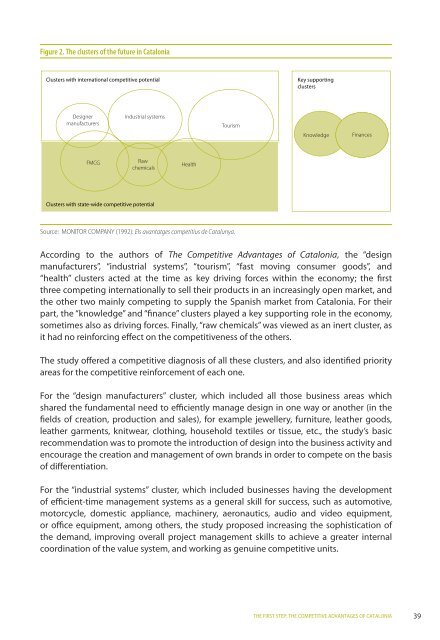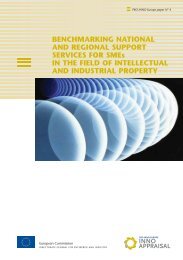Clusters and competitiveness - PRO INNO Europe
Clusters and competitiveness - PRO INNO Europe
Clusters and competitiveness - PRO INNO Europe
Create successful ePaper yourself
Turn your PDF publications into a flip-book with our unique Google optimized e-Paper software.
Figure 2. The clusters of the future in Catalonia<br />
<strong>Clusters</strong> with international competitive potential<br />
Designer<br />
manufacturers<br />
FMCG<br />
Industrial systems<br />
Raw<br />
chemicals<br />
<strong>Clusters</strong> with state-wide competitive potential<br />
Health<br />
Tourism<br />
Source: MONITOR COMPANY (1992): Els avantatges competitius de Catalunya.<br />
Key supporting<br />
clusters<br />
Knowledge Finances<br />
According to the authors of The Competitive Advantages of Catalonia, the “design<br />
manufacturers”, “industrial systems”, “tourism”, “fast moving consumer goods”, <strong>and</strong><br />
“health” clusters acted at the time as key driving forces within the economy; the first<br />
three competing internationally to sell their products in an increasingly open market, <strong>and</strong><br />
the other two mainly competing to supply the Spanish market from Catalonia. For their<br />
part, the “knowledge” <strong>and</strong> “finance” clusters played a key supporting role in the economy,<br />
sometimes also as driving forces. Finally, “raw chemicals” was viewed as an inert cluster, as<br />
it had no reinforcing effect on the <strong>competitiveness</strong> of the others.<br />
The study offered a competitive diagnosis of all these clusters, <strong>and</strong> also identified priority<br />
areas for the competitive reinforcement of each one.<br />
For the “design manufacturers” cluster, which included all those business areas which<br />
shared the fundamental need to efficiently manage design in one way or another (in the<br />
fields of creation, production <strong>and</strong> sales), for example jewellery, furniture, leather goods,<br />
leather garments, knitwear, clothing, household textiles or tissue, etc., the study’s basic<br />
recommendation was to promote the introduction of design into the business activity <strong>and</strong><br />
encourage the creation <strong>and</strong> management of own br<strong>and</strong>s in order to compete on the basis<br />
of differentiation.<br />
For the “industrial systems” cluster, which included businesses having the development<br />
of efficient-time management systems as a general skill for success, such as automotive,<br />
motorcycle, domestic appliance, machinery, aeronautics, audio <strong>and</strong> video equipment,<br />
or office equipment, among others, the study proposed increasing the sophistication of<br />
the dem<strong>and</strong>, improving overall project management skills to achieve a greater internal<br />
coordination of the value system, <strong>and</strong> working as genuine competitive units.<br />
THE FIRST STEP: THE COMPETITIVE ADVANTAGES OF CATALONIA<br />
39
















